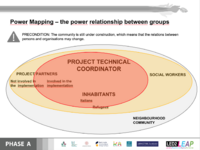LED2LEAP 2021 - Bologna Team 2: Difference between revisions
Marco.palma (talk | contribs) |
Marco.palma (talk | contribs) |
||
| Line 73: | Line 73: | ||
<gallery caption=" " widths="200px" heights="150px" perrow="5"> | <gallery caption=" " widths="200px" heights="150px" perrow="5"> | ||
File: | File:Bologna team2 PowerMapping power relationship.png|''power relationship'' | ||
File:PlaceholderImage_3.jpg|''insert text here'' | File:PlaceholderImage_3.jpg|''insert text here'' | ||
File:PlaceholderImage_3.jpg|''insert text here'' | File:PlaceholderImage_3.jpg|''insert text here'' | ||
Revision as of 16:27, 2 May 2021
>>>back to working groups overview
For help with editing this Wiki page use this link.
For assignments and key readings use this link.
| Area | blank | |
| Place | blank | |
| Country | blank | |
| Topics | blank | |
| Author(s) | blank, blank, blank, blank, blank | |

| ||
Landscape Democracy Rationale
- insert text here
Location and Scope
Salus Space, Bologna
Phase A: Mapping Your Community
Welcome to Your Community and Their Landscape
- insert text here
Groups of Actors and Stakeholders in Your Community
- insert text here
Relationships Between Your Actors and Groups
The community of inhabitants is still under construction and today only the 50% of the co-housing apartments are already assigned. In the next months new people will join the co-housing and will be included in the process, which means that the community-map is still un-complete, and other relevant actors may emerge in the future and the relations might change as well.
As described in the pictures, three different relations’ areas between groups have been identified: - Red circle: strong relation - Yellow circle: intermediate relation - Grey circle: weak relation.
The co-housing represents the main output of a European funded project. The consortium has already set the scene, designing the main activities, the monitoring indicators, and the expected outputs. Some of the partners have a stronger role in the project activities, and work on a daily base at Villa Salus. These organisations have the stronger relation with the inhabitants, which are supposed to became the main actors on the field.
Other actors potentially included in the process are the neighbourhood’s inhabitants, which are expected to benefit from the activities and at the same time contribute to develop them.
Summary of Your Learnings from the Transnational Discussion Panel
- insert text here
Theory Reflection
- insert text here
References
- insert text here
Phase B: Democratic Landscape Analysis and Assessment
The Scene in Your Story of Analysis
- insert text here
The Actors in Your Story of Analysis
- insert text here
The Story of Analysis
- insert text here
Reflect on Your Story of Analysis
- insert text here
Phase C: Collaborative Visioning and Goal Setting
The Scene in Your Story of Visioning
- insert text here
The Actors in Your Story of Visioning
- insert text here
The Story of Visioning
- insert text here
Reflect on Your Story of Visioning
- insert text here
Phase D: Collaborative Design, Transformation and Planning
Your Prototyping Action
- insert text here
The Evolution of Your Prototyping Action
- insert text here
The Plan Behind Your Prototyping Action
- insert text here
The Realization of Your Prototyping Action
- insert text here
Reflect on Your Prototyping Action
- insert text here
Phase E: Collaborative Evaluation and Future Agendas
Collaborative Evaluation and Landscape Democracy Reflection
- insert text here
The Actors in your Collaborative Evaluation
- insert text here
Reflection on the Online Seminar
- insert text here
Reflection on the Living Lab Process
- insert text here
Your Living Lab Code of Conduct
- insert text here
Process Reflection
- insert text here






















